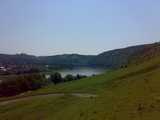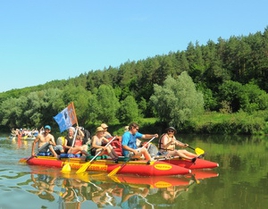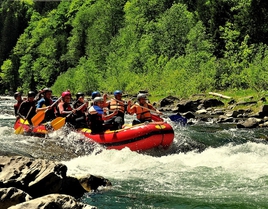Dniester as a transport artery of 50th XIX century
The middle of XIX century - a time of active improvement of lines of communication and transport vehicles. Leading European countries as well as USA are building railway tracks, implementing sea and river shipping, etc.. Gain momentum almost reckless competition of possession of new transport vehicles and international lines of communication, as lagging could lead to substantial gap between neighbors, and that would mean relevant losses: national economic, political, and military strategic ones. Within the borders of the state this competition was conducted at the local level, wherefore the central government was literally attacked by various projects, requests from local authorities, individuals, companies, societies and so on, about the improvement of lines of communication primarily of this particular region as an exclusive for the state. That is why appropriate is to consider the situation around Dniester water way in 50-th of XIX century in terms of reflecting contemporary minds, aspirations and expectation.
The Austrian point of view on Dniester
Looking at the Dniesters exploitation as a transport artery in the first half of XIX (both its Austrian and Russian parts), we see gradual quantitative growth of transported cargo, and partial adjustment works on it. All this occured against

the backdrop of leisurely bureaucratic mailing, considering of different projects and calming political situation. The first to wake up was Austria, its "springtime of nations" came like a mountain flood from the uphiils of Dniester, it broke the ice of "Metternich system". Have not yet faded completely political vicissitudes, russian army hasn't yet returned to its locations from Hungarian territory, and the Austrian government already planned several activities to start a new era foe economic development of the country and to influence this way on amendment of political situation. A daily newspaper about trade, industry and communications - "Austria" became a mouthpiece to popularize activities of The Minestry of Commerce, Industry and Public Building. So, on the 21-th of April in 1849, it reviewed the most important Mynestrys activities for improving transport lines of the empire. The newspaper informed:"Along with railways, The Minestry of Public Building intends to pay special attention to water constructions". Herewith, the first question on the agenda was improvement of water way of Sava, enabling large vessels navigation by Kulpa, and introducing of shipping by Dniester.
Russian part of Dniester
At the same time the Russian Empire "in the shadow of autocracy" and on the basis of "orthodoxy and nationality" was in state of deep complacency and smugness, the state lasted till The Crimean War in 1853-1856. The war demonstrated that famous "Russian Troika" can't chase after western steel-horse, "breathing with steam". It would be wrong to say, that the government of Nikolay The First didn't realize it at all. Proof to the contrary is a decree of June 5 1850, which proclaimed "the establishment of a free shipping in the empire", after its publication emerged the mojority of stock companies dealing with technical refitting of transport. However, the action of this law against the background of bureaucratic delays, id conditions of serf system couldn't give a result, demanded by needs of the day. It seemed that vast expanses of forests and steppes of The Russian Empire lull to sleep statesmen, effect on them hypnotically. An explosion was nesessary to open their eyes to reality. The Crimean War became such an explosion. Not for nothing a prominent russian economist V. P. Bezobrazov wrote: "Radical revitalization of our industrial and commercial affairs belongs to 1854-1857".
A new government headed by new emperor Oleksandr the Second, yet again starts to chase ever outrunning West. There wasn't desperately needed fund in state treasury. So, greater emphasis was put on reactivation of private initiative, in particular by corporatization of capitals. One of the most perspective directions was southwestern region of the european part of the empire. Thats why in Odessa in 1856 was established, by unprecedent intermadiation of government, one of the largest steamshipping companies of The Russian Empire - "The Russian Society of Shipping and Trade" (RSST). Besides of sea trips (internal and external), between Black sea and Azov ports, a society was to provide the implementing of navigation by Dnipro, Bug, Don. As we can see, Dniester at first wasn't included to ht esphere of influence of this mighty association.
 |
 |
 |
 |
Attempts to adopt Dniester for shipping
So, what kind of transport artery was Dniester then? During the analized period it was mostly not adjusted natural artery, interventions of human were few. On the austrian side since 1840 hydrotechnical constructios were acting, with the total length 10km 316m, in 50-th they were maintained but not multiplied. Their main purpose was to strengthen banks and support the suitability for shipping. Several activities on the russian banks held in 1800-1802, 1831, 1846 had no considerable effect to improving the Dniester navigation, and they couldn't have as they were restricted and spent fund were limited.
Thats why the waterbed of Dniester contained then a lot of shoals, pitfalls, sunk logs of trees, sand spits, etc., which significantly impeded shipping. The most serious danger and obstacle considered to be Yampilski Rapids. They constituted a granite belt of large rocks across nearly all the river. Between them was a pass about 52km wide, which was divided into two parts, each was to 4m deep. Rafts and boats passed this place by its right, bessarabian bank, as by podillian bank stranded below rapids. Slightly higher of rapids was a pitfall, served as a landmark - captains directed their watercrafts to it, to pass a granite belt by right side. This gave it the name "Storozh" (The Guard). At the same time this rock was dangerous - in case boat can not avoid the strike in speed flow the boat breaks at once.
Thereafter, conditions for transporting by Dniester were primitive and there were no shifts for the better in 1850-th. The banks, suitible for cargo , were rear and too narrow, they sink during floods. There were no convenient warehouses. The only stores build of stone housed 7500 quarters of grain situated in Demshyn a village of landowners Makovetski and in Serebria of Suliatytski, and considered to be a rare occurrence on the river.
Researches of Dniesters riverbed
Yet, despite the absence of direct hydroadjusted works and activities, 50-th were important in terms of examining the conditions of Dniester. Since that time main hopes were entrusted to the development of river navigation from that point was held the majority of research works on the river. On the russian side works began in 1856 and the results were set in the register of all places to improve. In order to define if Dniester waterbed is suitable for shipping in summer 1857 russian captain Romanov made a journey on Dniester.First, he passed its austrian part to the very beginnings. Then get back to the town Zhvanets and build a vessel there on which he sailed down to Mayaks. His report for russian government contributed the projects of entrepreneurship.
However, to introduce stemshipping Romanov foud it nessesary to deepen Dniester in its shallow areas and to dig navigative connective channels in plots with most steep turns. Perhaps, taking into account his proposals and based on another researches that very year the olan of purification was set, it proposed to deepen Dniester to 5 feet and mark with buyo the shoals.But next year, the society created for steamshipping Dniester fall apart, and planned activities haven't start untill the summer 1859. At the insistence of government, that had to be done by russian "Steam-Navigation-Company". For this purpose government garanteed a large subvention. It was intended to purify the river of sand shoals and sunk trees; to dig large channels to shorten 200 miles of the way. The total cost of all planned works was estimated at 1 000 000- 1 300 000 of silver rubles. To direct the project captain Romanov was entrusted.
After 1858 of rumers about the creation of Galician Steamshipping Society the same purifying and adjusting works started on the Austrian side of Dniester, as they expected profits from trading galician grains in Odessa. By detailed departmental researches Dniester purification from Rozvadov to the russian border didn't deman much funds. Austrians tended to think that no matter of russian steamshipping several purificating activitites are nesessary in terms of commerce and industry conditions and interests of the population of surrounding areas.
However in 1850-th none practical activities were held neither on Austrian nor on Russian side. Bur the researches was not in vain: in the beginning of 60-th the adjustment of Dniester finally started in two plots. The regular steamshipping as well was delayed for no proper preparations were held on both countries sides.
Anyway, in 1850-th the theme of steanshipping by Dniester was treated more seriously. Specific measures were taken at the end of 1950-th, when The Crimean War was finished. Unfortunetely, the information about next activities are extremely incomplete. We know the following. After the positive regards of captain Romanov, a society of nobles and landowners was established. For the purpose of steamshipping by Dniester the society order a steel steamsip from England suitable for Dniesters shallow places. At the same time it was clear, that for normal operating of this society apropriate corrective works on Dniester must be done, and they will be longlasting and expensive. Also the beginning of steamshipping by Dniester was planned for the summer of 1858, it was clear that for comletion of the project much more time should pass.
In 1858 the idea of steamshipping establishment in Dniester was supperted by few more companies. The R. Have House from Odessa planned to transport steamships from Odessa to Zhvanets. The RSST joined the business despite it didn't invove Dniester to plans before. On June 17 in 1858 Oleksander the Second sighed the decree about the establishment of Dniester steamshipping, and since then steamships began to transport grain from Mayakiv to Odessa.
Competition between two Empires
Steamshipping activity on the russian side of the river contributed the animation on austrian side. Were predicted routes from Rozvadiv to Zhvanets. In 1858 thanks to the efforts of the duke Lev Sapega - a man who did a lot for economic (and transport as well) development of north-east region of the country, - subscription for shares of future steamshipping society was started. Till the first of January in 1858 nesessary funds (120 000fl.) must have been collected and that would be enough to buy one steamship and a few towing barges. Also the negotiations on cooperation with RSST were performed.
In 1858 the society of nobles and landownes already have recieved the empirors concession, fall apart. The main reasons are - leck of money and doubts about perspectives. Its ideas adopted another company "Steam-Navigation-Company", but didn't perform any cractical activities as well.
In 1850-th negligible steanshipping was held in the Dniesters estuary. Since the end of 1830-th - beginnings of 1840-th between Akkermann and Ovidiopol plied state boat, it was unprofitable but the government maintained it to promote the inflow of private capital. From time to time came into the river commerse ships from the Black Sea. During the 1858 there were 8 of them, loaded mostly wheat.
In 1847 the attempts of private shipping performed a landowner form Podillya colonel Luba. He ordered from England a steanship, which thanks to its constrction can sail not only Dniester but its estuary and the sea to Odessa. It was suppesed to pull galleys upward by Dniester to Mogyliv-Podilskyi or even Khotyn. But actually it reached only Yampol. But its sailing was no regular, sometimes a steamship moved to Dnipro where towing was more profitable. During 1850 year it entered river a few ties and since 1858 colonel Luba never send it to Dniester again.
Rumors about the possibility to use staemships in Dniester were widely spread among local population. People hoped sincerely for economic upturn of their region with the development of steanshipping by Dniester.
and some statistics
So what was the commercial transportation by the river in those years? From the beginning of XIX century, especially in 30-th, was obvious increasing. For example, in 1825 by Dniester passed only 9 vessels and 65 barges, but in 1849 it was 449 vessels and 246 barges and were carried goods for 1,5mln rubles. The trend remained in 1850-th. For 9 years from 1849 till 1857 according to a research "The history of Moldova" by Dniester passed more than 10 thousands of vessels and transported goods for more than 10 700 000rubles. The data are the same in works of A. Zashchuk. He counted that total amount of vessels loaded in all wharves of Dniester annually was about 1427 whic gves us more than 10 thousands for 10 years and total cost of goods carried to Mayaky is 9 473 740 rubles in silver. The amount of workers employed at floatable works by Dniester during those 10 years was:
-
1849 - 3 582 people.
-
1850 - 5 138 people.
-
1851 - 4 412 people.
-
1852 - 9 112 people.
-
1853 - 7 932 people.
-
1854 - 1 196 people.
-
1855 - 2 120 people.
-
1856 - 3 264 people.
-
1857 - З 820 people.
-
1858 - 6 671 people.
Totaly for 10 years - 47 247 people.
Concerning the proportion of regions which used Dniester for own transporting needs, there are following data about russian Podillya. According to "Geographical dictionary of Polish Kingdom and others Slavic lands" set on the bases of russian governmental data, on Dniesters wharves of Podillya for 10 years since 1852 to 1862, was loaded on the vessels by amount and by cost: wheat - 1 687 277 quaters., corn - 644 478 quot., oat -208 032 quot., other grain - 110 786 quot., alkohol - 628 barrels, gorilka - 10 399 barrels, rosolio - 1 798 barrels, timber for 855 056 rub. in silver, gypsum - 759 370 pounds.Total cost - 6959389 rub. in silver. For transporting those cargoes were used 14 131 of vessels. Therefrom, average cost of goods louded in Podilska province for 10 years was 695 939 rub. in silver annually. Trade and transport turnover on podillian wharves for that period was distributed in following way: to Mogyliv-Podiskiy wharve - goods for 296 964 silv.rub., 43 %, Zhvanets - 184 654 rub. (27 %), Kalus 138 315 (20 %), Yampil 16 236 (2,5 %), Rashkiv 11 479 (1,5 %),Demshyn 7 777 (1 %), Serebria 6 202 (1 %); other wharves: Ushytsa, Koshnytsa, Studenytsa, Uishtsa,Yarudzi and others (2,25 %) . It shows that among rusian provinces - Bessarabia, Podillya and Novorosia - for own transport needs mostly used Dniester districts of Podillya province.
General statistics, presented here, as well as data about Podillya province can not be considered as quite typical. They could be greater, but the war suspended the quantitative growth of commerce trafic becouse of decline in trading activity in Odessa. This is evident from the amount of workers in 1854 - 1857 according to A. Zashchuk data. Perhaps the data of 1848 is not considered to be indicative as internal situation in Austria in 1848-1849 didn't promoted neither normal commerce between two empires nor revitalization in transporting on the russian side of the river. So, in 1845 from Galicia by Dniester were send 87 floatings in value 20 000 fl.; in 1846 relatively - 383 - 67000fl.; in 1847 - 909-102 000 fl.;in 184 - 277 -70 000 fl.; in 1849 - 543-105 000 fl.; in 1852 - 1065-64 000 fl.
Therefore, obvious is sharp decline of alloys and its value in 1848 and partly 1849 but there was significant rise just before it. Even considering the influence of objective factors ( dry summer, lower water level in the river, etc.) the decline is too sharp. At the same time, the influnce of political events of 1948-1949 on commerse transporting at the north-east area of Uastrian Empire needs more research.
Thereby, apparently of following quantitative indicators, the commercial transporting by Dniester in 50-th of XIX century was rather active, especially against the background of its full declination in previous centuries. However undeniable is the fact, that the proportion share of it within economic complex of surrounding areas varied but mostly minor. Transport capacity of the river was much stronger than was actually used on that time. Thats why several activities were held by authorities and individuals to rise an economic value of Dniester as a transport artery.
I. Zhaloba




